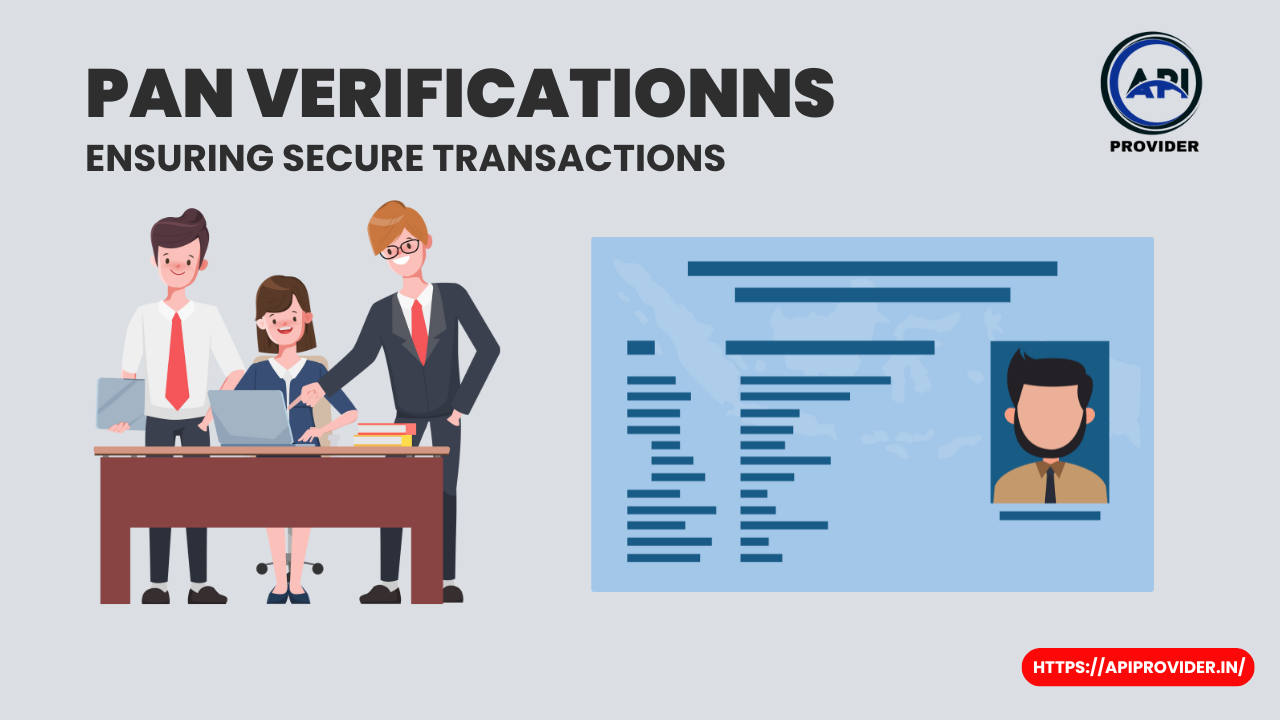PAN Verification: In today’s digital age, where financial transactions are increasingly conducted online, ensuring security and authenticity is paramount. One critical tool in this effort is the Permanent Account Number, or PAN. So, what exactly is PAN, and why is it so vital in financial transactions?
PAN is a unique ten-digit alphanumeric identifier issued by the Income Tax Department of India. It serves as a key to access financial information and is used for all transactions that might attract tax. This makes PAN an essential element for both individuals and businesses in India.

Understanding PAN Verification
Definition and Purpose
PAN verification is the process of validating the authenticity of a PAN. This ensures that the PAN number provided by an individual or business is valid and matches the records in the Income Tax Department’s database. The purpose of PAN verification is to prevent fraud, ensure compliance with tax regulations, and enhance the security of financial transactions.
Read More…
- How Banking UPI Services Impact Various Business Industries?
- How Payment APIs Help in Providing Payment Solutions
How PAN Verification Works
The process of PAN verification involves checking the details of the PAN card, such as the PAN number, the name of the holder, and other identifying information, against the records maintained by the Income Tax Department. This can be done manually or through automated systems using APIs provided by third-party vendors.
Why PAN Verification is Essential
Preventing Fraud and Identity Theft
With the rise in digital transactions, the risk of fraud and identity theft has increased. Verifying PAN details helps in confirming the identity of the parties involved, thereby reducing the chances of fraudulent activities.
Ensuring Compliance with Regulations
Compliance with tax regulations is crucial for businesses to avoid penalties and legal issues. PAN verification ensures that all financial transactions are recorded accurately and reported to the tax authorities as required by law.
Enhancing Financial Security
By verifying PAN details, businesses can ensure that they are dealing with legitimate entities. This enhances the overall security of financial transactions, protecting both businesses and consumers from potential risks.
Methods of PAN Verification
Online PAN Verification
The most common method of PAN verification is online. This can be done through various platforms, including government portals, banking websites, and financial service providers.
Offline PAN Verification
Though less common, offline PAN verification involves physical verification of PAN details. This method is generally used in cases where online verification is not feasible.
Third-Party API PAN Verification
Many businesses opt for third-party API providers for PAN verification. These APIs offer a seamless way to integrate PAN verification into existing business processes, ensuring real-time and accurate verification.
Steps to Verify PAN Online
Using Government Portals
Government portals like the Income Tax Department’s e-filing website provide tools for verifying PAN details. Users can enter the PAN number and receive verification results instantly.
Using Banking Websites
Banks also offer PAN verification services as part of their online banking platforms. This allows customers to verify their PAN details when opening accounts or conducting transactions.
Using Financial Service Providers
Various financial service providers and fintech companies offer PAN verification services, often integrated into their platforms for ease of use.
Benefits of PAN Verification
Accuracy and Reliability
Automated PAN verification through APIs ensures high accuracy and reliability, minimizing the risk of errors that can occur with manual verification.
Speed and Convenience
Online and API-based PAN verification methods provide instant results, saving time and effort for businesses and individuals.
Cost-Effectiveness
Using automated systems for PAN verification can be more cost-effective than manual processes, reducing administrative costs and resources required.
Challenges in PAN Verification
Data Privacy Concerns
Ensuring the privacy and security of sensitive data during the verification process is a major concern. Businesses must comply with data protection regulations to safeguard user information.
Technical Issues
Technical issues such as system downtimes or integration challenges can impact the efficiency of PAN verification processes.
User Errors
Errors in entering PAN details can lead to verification failures. Ensuring accurate data entry is essential for successful verification.
Role of API Providers in PAN Verification
Simplifying the Verification Process
API providers streamline the PAN verification process by offering easy-to-integrate solutions that can be embedded into existing business systems.
Real-Time Verification
APIs enable real-time verification, providing instant results and allowing businesses to make quick decisions.
Integration with Business Systems
PAN verification APIs can be integrated with various business systems, such as ERP and CRM platforms, enhancing operational efficiency.
Choosing the Right PAN Verification API Provider
Key Features to Look For
When selecting an API provider, look for features such as ease of integration, real-time verification, data security measures, and customer support.
Evaluating API Provider Reputation
Check the reputation of the API provider by reading reviews, seeking recommendations, and evaluating their track record in providing reliable services.
Cost Considerations
Consider the cost of the API service and ensure it fits within your budget while still providing the necessary features and reliability.
Implementing PAN Verification in Your Business
Step-by-Step Guide
- Choose an API Provider: Select a reputable API provider that meets your business needs.
- Obtain API Documentation: Get the necessary documentation for integration.
- API Key and Authentication: Register and obtain an API key.
- Integration: Work with your IT team to integrate the API into your systems.
- Testing: Test the integration thoroughly.
- Go Live: Deploy the API in your production environment.
Best Practices for Implementation
Ensure secure data handling, maintain accurate records, and regularly update your systems to keep up with regulatory changes.
Common Pitfalls to Avoid
Avoid neglecting data privacy regulations, skipping the testing phase, and choosing an unreliable API provider.
Legal and Compliance Aspects
Regulatory Requirements
Adhere to regulatory requirements for data handling and verification processes to avoid legal issues.
Ensuring Data Security and Privacy
Implement robust security measures to protect sensitive data during the PAN verification process.
Handling Non-Compliance Issues
Have a plan in place to address any non-compliance issues that may arise during PAN verification.
Case Studies of PAN Verification Success
Financial Institutions
Many financial institutions use PAN verification to prevent fraud and ensure regulatory compliance, enhancing the security of their transactions.
E-commerce Platforms
E-commerce platforms verify PAN details to validate sellers and buyers, ensuring trustworthy transactions.
Small Businesses
Small businesses leverage PAN verification to streamline their operations and maintain compliance with tax regulations.
Future of PAN Verification
Technological Advancements
Advancements in technology, such as AI and machine learning, are set to enhance the accuracy and efficiency of PAN verification processes.
Increasing Adoption Across Industries
As more industries recognize the benefits of PAN verification, its adoption is expected to grow, ensuring secure transactions across various sectors.
Emerging Trends
Trends such as the integration of blockchain technology and enhanced data analytics are likely to shape the future of PAN verification.
Conclusion
In conclusion, PAN verification is a crucial process for ensuring secure and compliant financial transactions. By leveraging modern technology and API providers, businesses can streamline the verification process, enhance accuracy, and protect against fraud. As the financial landscape continues to evolve, adopting robust PAN verification methods will be essential for maintaining trust and security in transactions.
FAQs
What is PAN and why is it important?
PAN (Permanent Account Number) is a unique identifier issued by the Income Tax Department of India. It is crucial for tracking financial transactions and ensuring tax compliance.
How can I verify my PAN online?
You can verify your PAN online through government portals, banking websites, or financial service providers that offer PAN verification services.
What are the benefits of using an API for PAN verification?
Using an API for PAN verification provides benefits such as real-time results, high accuracy, cost-effectiveness, and seamless integration with business systems.
Are there any legal requirements for PAN verification?
Yes, businesses must comply with regulatory requirements for data handling and verification processes to avoid legal issues.
What should I do if my PAN verification fails?
If your PAN verification fails, ensure that the PAN details entered are correct. If the issue persists, contact the verification service provider for assistance.
